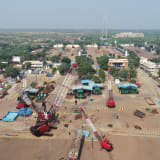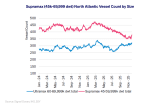
Ukraine’s iron ore export sector witnessed a significant rebound in 2024, with total exports rising by 90% year[1]on-year to 33.7 million tonnes (Mt), according to government data. Seaborne volumes were particularly strong, increasing nearly sixfold to 14.6 Mt, as per vessel tracking data. This short-lived recovery was fuelled by a blend of policy changes, improved maritime access, and resilient shipping arrangements.
The initial recovery came as Ukraine established temporary routes for non-grain carrying vessels in the Black Sea in August 2023 following Russia’s withdrawal from the Black Sea initiative. This allowed Ukrainian iron ore exporters to re-enter key markets such as China and the Middle East. The ability to move iron ore by sea, primarily using older Panamax and Capesize vessels, which made up roughly 99% of shipments, meant that larger volumes could be moved more economically. Shipowners willing to take on the elevated risk received crew bonuses and negotiated special insurance terms, helping to maintain supply chains through the region.
Domestic reforms also played a role. The Ukrainian government restored VAT refunds (which had previously been suspended) for large mining companies. Additionally, they also subsidised part of the expenses borne by shippers when using the Black Sea corridor. This gave producers some breathing room and contributed to export volumes climbing to 2.5 Mt in March 2024, approaching pre-war levels. Many hoped this signaled a sustained recovery.
However, the optimism proved premature. The Russian military escalated attacks in April 2025, destabilising several regions and crippling port and transport operations. The renewed violence mirrored the worst days of 2023, disrupting labour availability (both due to mobilisation and safety concerns) and preventing safe cargo handling at several key terminals. This meant that many facilities could not maintain consistent shipping schedules, leading to a sharp drop in export activity. Ports became difficult to operate, and many vessels refused to call at Ukrainian terminals.

Several miners in the region were already grappling with narrowing margins in 2024 due to rising operational costs and infrastructure damage, prompting them to scale back production despite government support measures. The situation worsened as Russian attacks rendered numerous coal and iron ore reserves in eastern Ukraine, particularly in Donbas, which holds an estimated 60 Bt of coal, inaccessible. Given that a significant portion of these domestic resources powers electricity generation, Ukraine has been forced to rely more heavily on expensive energy imports.
Energy security and rising costs have also strained Ukrainian steel mills. Nevertheless, they have managed to maintain a relatively stable level of output, declining a mere 2.5% y-o-y in Jan-May. Meanwhile, as China’s demand for iron ore continues to weaken due to its declining steel output, Ukraine faces intensifying competition from other suppliers in maintaining trade ties with China. The situation is further compounded by unstable raw material prices, high logistics costs, and tax inefficiencies, eroding Ukraine’s competitiveness in the global market. Ukraine’s iron ore exports to China fell 1.9% y-o-y to 8.3 Mt in 1h25, customs service data show.
Ukrainian iron ore producers are therefore pressured not only by rising OPEX and internal challenges, but also by weakening demand. As a result, several have found continued operations unviable and further reduced capacity this year to limit losses. Reflecting this, Ferrexpo reported a 34% drop in pellet production in 1h25. Looking ahead, the long-term outlook remains highly uncertain. Without stable infrastructure, consistent fiscal policy, and an end to the ongoing conflict, Ukraine’s iron ore industry faces significant headwinds.
By Vriddhi Khattar, Dry Bulk Analyst, Research, SSY.
Articles
You may also be
interested in
View allGet in touch
Contact us today to find out how our expert team can support your business














